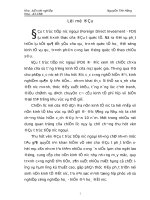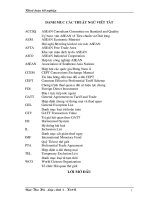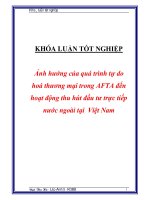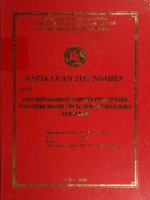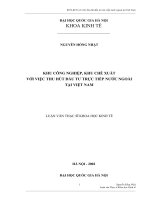Tác động của cộng đồng kinh tế ASEAN đến thu hút đầu tư trực tiếp nước ngoài tại việt nam tt tiếng anh
Bạn đang xem bản rút gọn của tài liệu. Xem và tải ngay bản đầy đủ của tài liệu tại đây (408.66 KB, 33 trang )
MINISTRY OF EDUCATION
MINISTRY OF FINANCE
AND TRAINING
ACADEMY OF FINANCE
CAO PHUONG THAO
THE IMPACT OF ASEAN ECONOMIC COMMUNITY
ON ATTRACTING FOREIGN DIRECT INVESTMENT
IN VIETNAM
Major: Finance - Banking
Code: 9.34.02.01
SUMMARY OF DOCTORAL DISSERTATION IN
ECONOMICS
HÀ NỘI – 2020
The thesis was completed at:
ACADEMY OF FINANCE
Supervisors:
1. Assoc.Prof Nguyen Tien Thuan
Examiner 1: ...................................................
Examiner 2: ...................................................
Examiner 3: ...................................................
The dissertation is to be presented at the thesis council academy level,
held at the Academy of Finance, at ....h...., date: .........................., 2020
The thesis is available at:
-
The National Library of Vietnam
-
The library of the Academy of Finance
PREFACE
1.
The Urgency of dissertation topic
In the context that the ASEAN economic community
(AEC) officially came into operation on December 31, 2015,
FDI from AEC has been increasingly evaluated as an
important financial resource that Vietnam needs to take
advantage of to create a spillover momentum for the economic
growth. Therefore, studying the movement of FDI in general
and FDI’s movement in the context of implementing
commitments in the ASEAN Economic Community to
Vietnam is a necessary requirement, from which, proposing
solutions useful measures to enhance the attraction of quality
FDI from partners inside and outside the ASEAN region.
Therefore, the author decided to select the topic "The
impact of the ASEAN Economic Community on attracting
foreign direct investment in Vietnam" as the content of the
thesis for Economic Doctoral thesis. With this research
direction, the author desires to develop a theoretical
framework reflecting the characteristics of FDI movement in
the AEC. On that basis, studying the impact of ASEAN
economic community on activities of attracting foreign direct
investment in Vietnam. These are important theoretical and
practical basis to propose useful solutions related to increasing
effective FDI attraction into Vietnam in the coming time.
2.
Research objects
- Assessing the Impact of the ASEAN Economic
Community on attracting foreign direct investment in Vietnam
when AEC officially came into operation in December 2015.
- Proposing some solutions related to factors affecting
FDI attraction into Vietnam under the impact of AEC, in order
1
to attract FDI effectively in the context of implementation of
AEC commitments.
3.
Research subject and scope
Research subjects: The impacts of the ASEAN
Economic Community on factors affecting the attraction of
foreign direct investment into Vietnam.
Research scope:
+ Time frame: from 2005 to 2018
+ Space limitation: Vietnam's FDI from countries inside
and outside ASEAN.
4.
Research methodology
According to the method of collecting information, the
thesis is conducted mainly by the method of studying
documents to collect information related to published
theoretical bases, relevant policies and statistics.
According to the method of data analysis, the thesis
applied two methods: qualitative method and quantitative
method.
- Qualitative analysis: identification of groups of factors
affecting FDI attraction.
- Quantitative analysis: verifying the impact of the
ASEAN Economic Community on attracting FDI into
Vietnam by linear regression model. In which, dependent
variable is the amount of FDI into Vietnam, explanatory
variable are the quantifiable representatives that reflect the
factors affecting FDI attraction into Vietnam.
5.
Contributions of dissertation
Systematize the theoretical content related to the impact of
International Economic Linkage to attract FDI into a member
country.
2
Analyze and assess the impact of AEC on FDI attraction
into Vietnam through PESTLI theoretical model of groups of
factors affecting FDI.
Propose some solutions to effectively attract FDI in the
context of implementing commitments in the ASEAN
Economic Community.
6.
Theoretical and practical meaning of the dissertation
Generalizing the theory of the impact of international
economic linkage on FDI attraction into a country through the
PESTLI theoretical model of groups of factors affecting FDI
attraction into a country.
Identifying factors affecting FDI attraction in Vietnam
under the impact of AEC, and analyze and evaluate the
impacts created by AEC on FDI attraction in Vietnam
7.
Dissertation structure
In addition to the introduction and conclusions,
references, appendices, the thesis is structured into 4 chapters:
Chapter 1: Literature review on research topic
Chapter 2: General theory of FDI attraction and the
impact of international economic integration on FDI attraction.
Chapter 3: Impact of ASEAN economic community
(AEC) on attracting foreign direct investment into Vietnam
Chapter 4: Solutions to enhance FDI attraction into
Vietnam in the context of implementing AEC commitments.
3
Chapter 1
LITERATURE REVIEW ON RESEARCH TOPIC
1.1.
INTERNATIONAL AND VIETNAM
LITERATURE REVIEW
1.1.1. Research on FDI and attracting FDI
a. Vietnamese literature review
Studies on FDI in general and FDI attraction both
recognize the need for FDI and FDI attraction activities for the
host country. In addition to receiving investment capital,
receiving countries can also receive other resources such as
technological know-how, management experience, marketing,
opportunities to participate in global production networks, etc.
(Lall, 2000). Therefore, FDI is seen as an important
motivation for receiving countries, especially developing
countries with opportunities for economic growth (OECD,
2002). Effective policies to attract FDI depend on the specific
characteristics of each country. A country that wants to attract
foreign investors needs to create a favorable environment by
minimizing the complex management costs.
Regarding the factors affecting FDI attraction, many
studies in the world have pointed out the different factors and
groups of factors as well that affecting the volume and
distribution of FDI in developing countries in the world:
political stability, preferential tax policies and supportive
policies for investors, and a good business environment. In
addition, other factors include the labor force, domestic
investment, the level of trade openness, living standards,
current accounts, foreign debt, institutions and the structure of
4
the economy. These are also factors that affect FDI into
developing countries.
b. International literature review
In Vietnam, researches on FDI and FDI attraction have
been carried out and mainly focused on aspects such as
general theoretical issues on FDI, on policy system of FDI
attraction, FDI attraction experience. of other countries, the
investment environment, the impact of FDI on the sides of the
economy ... Besides qualitative studies, several quantitative
studies have also been conducted in Vietnam. In addition to
the general studies, FDI by partner, FDI by economic zone and
FDI by sector are also topics of interest in Vietnam.
Based on an overview of FDI in Vietnam, domestic
studies have shown the role of the FDI sector in the
Vietnamese economy, FDI policy in Vietnam, the impact of
FDI on growth through investment channels and spillover
effects of FDI in Vietnam on labor productivity. The results of
the study show that market size, infrastructure quality, labor
quality, and corporate concentration have an impact on foreign
direct investment and are spillover from local boundaries.
1.1.2. Research on impacts of International economic
integration on attracting FDI
a. International literature review
Dunning's OLI model with capital ownership,
investment location and localization, are emphasized as
determinants of FDI capital movement. Some other authors are
more interested in the model of gravity - thrust to explain the
movement of FDI. In addition, some other studies focus on the
movement of FDI under the influence of globalization of
production factors or the impact of science and technology
5
effects from Multinational companies, international economic
- financial institutions or macroeconomic policies to FDI.
b. Vietnamese literature review
Some domestic studies also mention the impact of
economic integration trends on FDI, focusing on the following
aspects: Contribution of integration into the country's socioeconomic development; impact on improving the investment
environment, great opportunities for Vietnam's investment
sector.
1.1.3. Research on impacts of AEC on attracting FDI
a. International literature review
A number of international studies on the impact of the
AEC are aimed at understanding the long-term challenges to
foreign direct investment and trade (FDI) and the Association
of Southeast Asian Nations ( ASEAN). The econometric
evidence shows that (i) intra-regional trade and FDI have a
mutually reinforcing effect, that is, the increase in trade flows
stimulates FDI inward and vice versa; (ii) a large market
attracts more FDI; (iii) FTAs tend to help stimulate foreign
investment; and (iv) strong institutions, good facilities and low
operating costs play a very important role in promoting FDI.
b. Vietnamese literature review
In general, studies on the impact of AEC on FDI in
Vietnam focus primarily on assessing the opportunities and
challenges of AEC on FDI inflows into Vietnam. The studies
show typical opportunities and challenges for FDI attraction
for Vietnam in general and for specific industries.
1.2.
GENERAL ASSESSMENT ON LITERATURE
REVIEW
6
1.2.1.
Research gaps
Firstly, the gaps in the scope of research for receiving
countries: can expand the scope of research for Vietnam.
Secondly, the gap in the scope of research for
international economic links: can expand the scope of research
for international economic links of ASEAN, including the
ASEAN Economic Community.
Thirdly, the gap in the research object is the impact of
international economic links on FDI attraction.
Fourth, the gap on the impact of international economic
links on the quantity and quality of FDI attraction in the host
countries.
1.2.2. Research orientation
- In terms of theory:
(i) systematize the theoretical issues of foreign direct
investment, attract foreign direct investment,
(ii) factors affecting the attraction of foreign direct
investment. and,
(iii) the impact of international economic links on the
attraction of foreign direct investment.
- In terms of practice:
(i) Analyze and develop a framework to study the
impact of AEC commitments on each group of factors
affecting FDI attraction in Vietnam.
(ii) Assess the impact of AEC on FDI inflows in
Vietnam.
(iii) Recommend a number of policy solutions to
effectively increase FDI attraction in the context of
implementing the commitments of the ASEAN Economic
Community.
7
Chapter 2
OVERVIEW ON ATTRACTING FDI AND IMPACT OF
INTERNATIONAL ECNOMIC INTEGRATION ON
ATTRACTING FDI
2.1. OVERVIEW ON FDI AND ATTRACTING FDI
2.1.1. Definition, features and roles of FDI
Studying and inheriting the concepts of FDI: Foreign
direct investment means the transfer of resources by foreign
investors (both tangible and intangible) to receiving countries
for investment. production and business activities, aiming to
maximize profits.
Within the scope of the thesis, the researcher focuses on
FDI research as the movement of cash resources (investment
capital) of foreign investors, since the statistics on cash capital
are relatively full in compared with the other figures related to
intangible and other tangible assets
Features of FDI
Firstly, FDI is not merely the movement of capital
sources, but also implies the process of transfering technology,
management experience ... from the host country to the
investee. Secondly, FDI is a long-term capital inflow. Thirdly,
the organization and operation of FDI-formed enterprises are
carried out on the basis of international practices and the laws
of the host country. Fourthly, the regional distribution
relationship is the settlement of the relationship of economic
benefits between entities involved in production and business
activities. Fifthly, the purpose of foreign investors is to
maximize profits. Sixthly, FDI is under the simultaneous
impact of the socio-economic situation involved countries.
8
Foreign direct investment (FDI) plays an important role
in the development of the host country's economy. In addition
to providing capital, FDI is also the means of receiving
countries to: (i) acquire technology, knowledge, management
skills and other important inputs; (ii) integrate into
international distribution, marketing and production networks;
and (iii) improve the international competitiveness of
enterprises and the economic efficiency of the host country.
2.1.2. Factors affect on attracting FDI
The PESTLI model is used to study the factors
existing in the macro environment that are likely to affect
production and business activities in general and activities to
attract foreign direct investment. Analysis of the PESTLI
model will show the advantages as well as the competitive
disadvantages that exist in the macro environment of the host
country. PESTLI model includes six elements, including:
Political factors (P): reflects the institutional-political
stability, including stability in matters related to political and
diplomatic conflicts of institutions laws in the country of
investment.
Economic factors (E) The group of economic factors
reflects the conditions inherent in the host country market that
foreign investors seek.
Social factors (S) Besides culture, factors of social
characteristics also make businesses interested in conducting
market research. Social factors will divide the community into
customer groups, each with different psychological
characteristics, income ...
Technology factors (T) FDI investors will assess the
technology level of the host country to have a solution to
9
select the appropriate level of technology to conduct
production and business.
Legal factors (L). The FDI policy framework includes
principles and regulations governing market entry, activities of
foreign investors, and rules for dealing with foreign investors.
Integration factors (I). In the process of globalization,
international financial and investment activities are promoted.
2.1.3. The criteria reflected the results of FDI attraction
In terms of quantity: This indicator system allows direct
assessment of FDI attraction results in the host country. This is
a traditional group of criteria with criteria to assess the scale of
FDI capital that an economy has received. Including: FDI's
contribution to the total social investment; Registered capital
scale; Scale of implemented capital; Scale of capital / project;
FDI structure; Form of investment;
In terms of quality: the system of quality indicators
attracts FDI to evaluate the results that FDI contributes to
improve the competitiveness of the economy. The quantitative
indicator group includes the following indicators: Contribution
of FDI to economic growth; Contribution of FDI to the
international balance of payments; Ability to create jobs;
Technology transfer efficiency; The degree of association of
the FDI sector with domestic enterprises; The impact of the
FDI sector on the environment.
2.2. BASIC THEORY ON THE IMPACT OF
INTERNATIONAL ECONOMIC INTEGRATION ON
FDI ATTRACTION
2.2.1. Theory on international economic integration
International economic integration is considered as the
process of linking a nation's economy and markets to the
10
world and regional economies and markets through measures
of market liberalization and market opening at all levels.
unilateral, bilateral and multilateral.
International economic integration is taking place as an
indispensable trend of the world economy today as a result of
the development of production forces and social labor division
2.2.2. Impact of international economic integration on FDI
attraction
The impact of regional-level international economic
integration on FDI attraction is realized through the impact of
commitments in economic integration, thereby influencing the
groups of factors that influence the choice of choice.
investment locations in the host country. These effects may
vary according to the characteristics of each link and the
characteristics of each economy receiving investment.
a. Factors affecting the degree of impact of regional
economic integration on FDI attraction in a specific country
The first is the scope and depth of agreements in a
regional economic link, thereby determining the degree of
harmonization of policies and the changes that member
countries must make in pursuit of the integration area.
Second, the reliability of regional economic links
(expressed to the extent that the terms of this linkage is made)
is another factor that determines the impact of regional
economic integration on FDI attraction.
The third is the trade and investment relations of
nations before the establishment of regional economic links.
Fourth, the unique advantages that the economy
creates when it is a member of a Regional Economic Linkage.
11
b.
Mechanism of impact of regional international
economic integration on attracting FDI into member states
The impact of regional economic linkages on FDI
attraction into a country is realized through the impact of
commitments in regional linkages on groups of factors
affecting FDI attraction, including: institutional - political (P),
economic (E), social (S), technological - technical (T), policy legal (L) and factor integration (I).
c.
Scope of influence of regional economic linkage on
FDI.
The impact of international economic links on the
movement of FDI is formed by the effect of commitments in
each international economic link. There are commitments that
will help recipient countries to attract FDI from member
countries (intra-regional FDI), while there are also
commitments to create opportunities for receiving countries to
attract more FDI from other outside-of-the-bloc countries.
Regional cooperation has led to an increase in
investment diversification through investment restructuring
within the area of cooperation. Regional integration activities
often lead to increased FDI through the opening of investment
sectors and adjustment of investor treatment policies.
FDI outside the regional economic bloc may increase
as a result of increasing market size, which is particularly
important for economic linkages of developing economies, or
for significant alternative action in which regional economic
integration creates barriers to trade outside the bloc.
2.3. OVERVIEW ABOUT ASEAN ECONOMIC
COMMUNITY
12
2.3.1. ASEAN Economic Community Establishment
The ASEAN Economic Community (AEC) 2015 is
the result of the process of regional economic integration
among 10 ASEAN members since 1967 (for Vietnam, 20
years of participation since 1995). The vision for AEC
development was set by ASEAN leaders at the 30th
Anniversary of ASEAN Establishment in 1997 with the goal
of developing ASEAN into a thriving economic region,
through liberalization and facilitation. trade and investment in
the region, at this time, ASEAN Vision 2020 is adopted.
Figure 3.1 summarizes the main development steps towards
the goal of establishing AEC 2015 and completing by 2025.
- AEC 2015 consists of four main pillars:
- A common market and production base
- A highly competitive economic area.
- An area of uniform economic development.
- The region fully integrates into the global economy.
2.3.2. Main commitments in AEC
The ASEAN Investment Agreement (ACIA), the
ASEAN Trade in Goods Agreement (ATIGA), the ASEAN
Services Framework Agreement (AFAS) and the ASEAN
Agreement on Movement of Natural Persons (MNP) are some
of the key commitments. forming characteristics of regionallevel economic linkages in the AEC.
13
Chapter 3:
IMPACTS OF ASEAN ECONOMIC COMMUNITY (AEC)
ON ATTRACTING FOREIGN DIRECT INVESTMENT
IN VIETNAM
3.1. FDI results in Vietnam in general
3.1.1. The indicators reflect the FDI quantity into Vietnam
Survey of indicators reflecting the number shows some
characteristics of FDI into Vietnam in the period of 2005-2017
as follows: (i) After a period of sharp decline in 2008-2009
due to the impact of the world economic downturn. gender, the
situation of FDI registered in Vietnam has been gradually
restored; (ii) the ratio of implemented FDI to registration is
about 50%; (iii) the proportion of FDI in the total social
investment capital is more than 20%; (iv) the number of FDI
projects tends to increase with the project size of about 6.9
million USD / project; (v) FDI in Vietnam has a high degree
of concentration; (vi) FDI in Vietnam has a high level of
industry concentration; and (vii) Investors from Asia account
for up to 50% of total FDI in Vietnam.
3.1.2. The indicators reflect the FDI quality into Vietnam
Survey of indicators reflecting the quality shows that
some characteristics of FDI into Vietnam in the period of
2005-2017 are as follows: (i) the FDI sector has contributed to
GDP growth in Vietnam; (ii) contribute to job creation; (iii)
the level of contribution to increasing national labor
productivity is limited; (iv) a leading force in export activities;
(v) The efficiency of technology transfer of the FDI sector
remains relative low.
3.2. INVESTMENT COMMITMENTS IN AEC AFFECTING
14
FDI ATTRACTION INTO VIETNAM
Currently, investment activities in ASEAN are
governed by the ASEAN Comprehensive Investment
Agreement (ACIA), effective March 29, 2012. ACIA is the
successor and adjustment from the 1987 ASEAN Investment
Promotion and Protection Agreement (AIGA) and the ASEAN
Investment Area Framework Agreement (AIA) in 1998 to suit
new conditions and integration needs. within ASEAN 2020
vision. ACIA includes 49 articles, 2 appendices and 1
reservation list.
Regarding investment-related obligations, ACIC
adjusts the measures of Member States applicable to investors
and current or future investments (from the time of ACIA's
entry into force) of investors of member countries.
Regarding investment liberalization, ACIA only has
commitments on investment liberalization in the fields of
manufacturing, agriculture, fisheries, forestry, mining,
ancillary services for the above industries and real estate. Any
other areas if the members agree.
a. Rules in ACIA
Promote investment liberalization, protection,
promotion and facilitation
- Bring benefits for both ASEAN investors and foreign
investors investing in ASEAN.
- Continue to maintain the most favored nation
treatment and preferential treatment among members.
- No retroactivity of commitments achieved in AIA and
AIGA
- Providing special treatment to new member countries
(CLMV group)
15
-
Give flexibility to member countries on sensitive
issues.
- There is reciprocal treatment between member
countries
- Allow the Agreement to expand the scope of the
subject to other sectors in the future.
b. Investment obligations in ACIA:
- Non-discrimination obligations: National treatment
(NT); Most favored nation treatment (MFN)
- Performance requirements
- Requirements for senior management and board of
directors.
c. Investment guarantees in ACIA
- ACIA includes a number of regulations to ensure the
interests of foreign investors and their investments
when investing in an ASEAN country.
- ACIA introduces a State-foreign investor dispute
settlement mechanism, which allows investors who
have disputes with the host country to sue the country
for an independent arbitration mechanism.
In general, the ACIA Agreement inherits the provisions of
the IGA and AIA but has introduced many new points to
improve the investment environment.
3.3. IMPACTS OF AEC ON ATTRACTING FDI INTO
VIETNAM
3.3.1. Impact’s mechanism
Commitments in AEC will affect the "hexagon
PESTLI" in the direction of expanding the hexagon, increasing
favorable conditions to attract more capital flows from within
the AEC and outside the AEC block to Vietnam.
16
3.3.1.1. Political factors (P)
Data on the political stability index (SPI) and FDI
capital implemented in Vietnam in the 2006-2017 period
shows the existence of a correlation between FDI and SPI,
implying that, in Vietnam in the period 2005-2017, the factor
of political institutional stability influences FDI investors'
decisions.
The correlation between the political stability index and
FDI made in Vietnam in the 1996-2006 period was calculated
at -0.66, reflecting the non-positive relationship of the two
data above. This can be explained by two reasons: First,
political stability is not the only factor in investors' decision on
FDI investment. Second, FDI investment decisions are
influenced by the SPI, but have the effect of time lag (about 5
years).
3.3.1.2. Economic factors (E)
Firstly, AEC supports market growth
The least square regression analysis results show that,
before the AEC, the GDP variable was positively correlated
with registered FDI and explained 15.8% of the fluctuation of
FDI into Vietnam. Meanwhile, after the AEC, the GDP
variable is positively correlated with registered FDI and only
explains 0.7% of the fluctuation of registered FDI into
Vietnam. NCS said that one of the reasons why GDP does not
explain much for registered FDI is because when creating a
common market, the market growth factor of an economy will
no longer be the factor. decided to attract FDI.
Secondly, AEC supports the expansion of trade in
goods and services - motivations for FDI investors to find
17
markets, not only Vietnamese market, but also AEC market
and partner markets of AEC.
In the period before AEC (2005-2015), Vietnam
witnessed a continuous increase in export value. Export value
has an impact on the FDI situation in Vietnam, reflecting the
investment objectives of FDI investors in Vietnam, mainly
directed toward the production of exports. The least square
regression results with 99% confidence indicate a positive
correlation between export value and FDI made in Vietnam in
the period before AEC (2005-2015), accordingly, the export
value variable explain 65.39% of the change in implemented
FDI. In addition, trade openness (ratio of import-export value
to GDP) is also positively correlated with implemented FDI
and explains 71.28% of the fluctuation of implemented FDI.
Export value and registered FDI in Vietnam during the
research period are not statistically significant.
3.3.1.3. Social factors (S)
The relationship between implemented FDI and the
labor force is quite clear. With 99% confidence, the least
squares univariate regression results in an adjusted R square of
about 80%. Thus, it can be noticed that the labor force has a
positive correlation with implemented FDI and is one of the
important variables that explain about 80% of the fluctuation
of FDI made in Vietnam in the previous period (2005-2015).
3.3.1.4. Technology factors (T)
Due to the limited number of observations, the PhD
student could not confirm the relationship between the amount
of FDI implemented in Vietnam and the spending on research
and development. The remaining indicators include the
innovation index and the export value of high-tech products,
18
although positively correlated with implemented FDI, but the
level of explanation is low, about 33% and 40% respectively.
This result is consistent with many conclusions about the goal
of FDI in Vietnam to take advantage of policies, markets and
labor rather than seek technological advantages in Vietnam.
The Global Innovation Index (GII) is a Worldbank
annual index that reflects part of a country's long-term
technological level. In 2017, Vietnam reached 38.3 points in
this Index and ranked 3rd in the group of 8 members rated
AEC.
3.3.1.5. Legal factors (L)
Firstly, it has put pressure on member states, including
Vietnam, to implement reforms in the direction of investment
liberalization to meet ACIA's provisions.
Secondly, ensuring the process of investment
liberalization through commitments to protect the interests of
investors is reflected in the FDI policy framework of member
countries.
Thirdly, in the spirit of ACIA's freedom and
facilitation of investment, member states are proactive in
designing preferential policies and investment procedures.
Fourthly, the signing of AEC as an official and active
member in ASEAN, Vietnam is considered as one of the
proactive countries in the process of AEC integration in
general and investment liberalization in particular. .
Fifthly, in addition to implementing commitments to
liberalize investment, Vietnam has also implemented a series
of other commitments, demonstrating the harmonization of
policies between Vietnam and AEC in many respects.
3.3.1.6. Integration factors (I)
19
Firstly, in AEC Vietnam is one of the countries with the
least developed economy, Vietnamese enterprises face 5
challenges: competition on goods, competition on services,
competition on attraction. In the meantime, we have to face
trade remedies and requirements with increasing quality of
goods as well as business methods. The four countries of
Cambodia, Laos, Myanmar and Vietnam still lack institutional
capacity to keep pace with the economic linkages of former
ASEAN-6 members.
Secondly, Vietnamese workers have the lowest
productivity and labor discipline in the region. Lack of highly
qualified and skilled labor, Vietnam's position in labor
productivity ranks 6th in the region (period 2009 - 2012). In
addition, at present, Laos, Cambodia, Myanmar and Vietnam
are the four countries without a national standard occupational
framework.
Thirdly, the preparation of Vietnam when entering the
AEC has been happening but still slowly, many individuals
and businesses have not been aware of integration pressures,
many policies are still slow to be amended and issued. onions;
The interest, understanding and setting out appropriate steps of
many enterprises on AEC are still ambiguous.
3.4. ASSESSMENT ABOUT IMPACTS OF AEC ON FDI
ATTRACTION INTO VIETNAM
3.4.1. Qualitative evaluation
PESTLI analysis is performed on a 5-point scale for each
element in the PESTLI hexagon. In the case of Vietnam, although
it has just officially operated since December 31, 2015, the AEC
has created specific impacts on FDI attraction activities, reflected
in the change of factors in the framework. PESTLI analysis after
20
AEC compared with before AEC.
By the end of 2018, in general, AEC has not made many
changes in the attractive factors in Vietnam. The shape of
PESTLI frame in Vietnam before and after the AEC almost
has not changed much. The results of this study reaffirmed that
the advantage of political stability (Factor P) remains an
important advantage of Vietnam in the context of
implementing commitments in the ASEAN Economic
Community (AEC).
Although there have not been many breakthroughs in
improving competitive advantage, in the context of
implementing AEC's commitments, except for P, no other
factors of PESTLI have been reduced. Economic factors,
social factors, technical-technological factors, legal institutions
and integration factors, although changing slowly, are all
improving after the AEC. In which:
- Economic factor (E) is the least advantageous factor of
Vietnam but it is the strongest improvement index.
- Getting a lot of improvements after AEC (after the
Economic factor (E)) is the institutional - legal factors (L) and
social factors (S). For L, Vietnam's score increased by 4.83%
from 2.07 points to 2.17 points. For S, Vietnam's score
increased by 4.48% from 0.647 points to 0.676 points.
- Technology - Technical is the second least
advantageous factor (after E) in the PESTLI analysis
framework. Before and after the AEC, T is also the least
improving factor. Although PESTLI score of T in Vietnam has
increased from 1,785 to 1,820 points, the increase is only
1,96%.
3.4.2. Quantitative evaluation
21
To determine the influence of the ASEAN Economic
Community on the amount of FDI inflows to Vietnam in
recent years, the PhD student used a multivariate linear
regression model to calculate the correlation of the factors in
the PESTLI model to direction and impact of FDI inflows into
Vietnam. The application model has the form:
FDI i = fi (P, E, S, T, L, I) (1)
In particular, FDIi is an independent variable, reflecting
the amount of FDI implemented into Vietnam over the years
of research. The variable FDIi is explained by the linear
regression function of 16 variables.
FDI data is gathered based on the General Statistics
Office's annual socio-economic situation; The data of 11
explanatory variables is collected according to the WB data,
updated to 2018, Particularly the GII data in 2010 is the
average author's data for 2009-2010.
The linear regression analysis with 1% significance
level for models (1), (2), (3), (4), (5), (6) and (7) brings the
conclusions. main as follows:
- FDI is best explained by three groups of factors: S, T and
P; In particular, the best explanation for FDI into Vietnam
in the research period is the factors related to the labor
force advantages and the upgrading of technical
infrastructure and transportation capacity at. Political
stability is still considered as an advantage in Vietnam's
FDI attraction in the research period.
- About 89.55% of the change in registered FDI in Vietnam
is explained by the model of changes in registered FDI
from 4 main partners from AEC to Vietnam. In addition,
the trend of increasing investment capital is evident in 3
22
-
-
partners: Singapore, Thailand and Malaysia; Past results
indicate a trend of capital reduction in Brunei in Vietnam.
AEC countries are interested in three areas of Vietnam,
including mining, retail and real estate. The regression
results of these three areas indicate a positive correlation
and a good level of interpretation of the four AEC
countries to the change in FDI by sector, respectively
95%, 80.6%, 78%.
Regarding FDI by economic zoning, the regression results
(6) show the statistically significant positive relationships
of the four main AEC partners in Vietnam to the change in
registered FDI in two economic regions. The North and
South Central Coast and the Mekong Delta Economic
Region, with explanations of 91.7% and 83.7%,
respectively.
23
